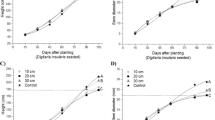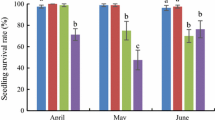Abstract
Agrosilvopastoral systems present high potential as a sustainable agriculture technique, despite the current limiting points in the systems management that must be overcome. A major bottleneck in the implementation of these systems is the damage caused, to forest species, by the application of herbicides for weed control in the crop component. The present study evaluated the selectivity of herbicides in seedlings of two tree species native to the Brazilian Cerrado, Dipteryx alata (Vog.) and Anadenanthera colubrina var. cebil (Griseb.) Altschul, and two eucalyptus clones, E. urograndis and E. urocam. The study was conducted in a greenhouse, with two commonly-used herbicides (glyphosate and mesotrione), in five different doses. The sensitivity of tree species to the herbicides was evaluated through physiological, morphological and visual phyto intoxication characteristics. For glyphosate, the tree species exhibited strong phytotoxicity symptoms from the second day after application, being the symptoms more prominent in the two eucalyptus clones and less in D. alata, which presented higher tolerance to this herbicide. For mesotrione, the four tree species studied showed mild toxicity symptoms, with very little or absent significant impacts in growth and biomass accumulation. The herbicide mesotrione was shown to be selective for the four tree species studied and can be recommended to agroforestry systems in which these species are present. These results based on phytotoxicity grades are reinforced by the biometric and physiological parameters measured.




Similar content being viewed by others
Availability of data and material (data transparency)
The datasets generated during and/or analysed during the current study are available from the corresponding author on reasonable request.
References
Agostinetto D, Tarouco CP, Markus C, Oliveira E, Silva JMBV, Tironi SP (2010) Seletivicty of eucalyptus genotypes to herbicides rates. Semina: Ciências Agrárias 31:585–598. https://doi.org/10.5433/1679-0359.2010v31n3p585
APG – Angiosperm Phylogeny Group IV (2016) An update of the angiosperm phylogeny group classification for the orders and families of flowering plants: APG IV. Bot J Linn Soc 182: 1–20
Balbino LC, Cordeiro LAM, Porfírio-da-Silva V, Moraes A, Martínez GB, Alvarenga RC, Kichel AN, Fontaneli RS, Santos HP, Franchini JC, Galerani PR (2011) Evolução tecnológica e arranjos produtivos de sistemas de integração lavoura-pecuária-floresta no Brasil. Pesqui Agropecu Bras 46:1–12. https://doi.org/10.1590/S0100-204X2011001000001
Balbino LC, Kichel AN, Bungenstab DJ, Almeida RG (2012) Sistemas de integração: o que são, suas vantagens e limitações. In: Bungenstab DJ (eds) Sistemas de integração lavoura-pecuária-floresta: a produção sustentável, 2ª ed. Embrapa, Brasília, pp 11–18.
Beaudegnies R, Edmunds AJF, Fraser TEM, Hall RG, Hawkes TR, Mitchell G, Schaetzer J, Wendeborn S, Wibley J (2009) Herbicidal 4-hydroxyphenylpyruvate dioxygenase inhibitors - A review of the triketone chemistry story from a Syngenta perspective. Bioorg Med Chem 17:4134–4152. https://doi.org/10.1016/j.bmc.2009.03.015
Bethke RK, Molin WT, Sprague C, Penner D (2013) Evaluation of the interaction between glyphosate and glufosinate. Weed Sci 61:41–47. https://doi.org/10.1614/WS-D-12-00031.1
Calil FN, Lima NL, Silva R, Moraes MDA, Barbosa PVG, Lima PAF, Brandão DC, Silva-Neto CM, Carvalho HCS, Nascimento AR (2016) Biomass and nutrition stock of grassland and accumulated litter in a silvopastoral system with Cerrado species. Afr J Agric Res 11:3701–3709. https://doi.org/10.5897/AJAR2016.11369
Cerovic ZG, Masdoumier G, Ghozlen NB, Latouche G (2012) A new optical leaf-clip meter for simultaneous non-destructive assessment of leaf chlorophyll and epidermal flavonoids. Physiol Plant 146:251–260. https://doi.org/10.1111/j.1399-3054.2012.01639.x
Christensen MG, Teicher HB, Streibig JC (2003) Linking fluorescence induction curve and biomass in herbicide screening. Pest Manag Sci 59:1303–1310. https://doi.org/10.1002/ps.763
Cole D, Pallet K, Rodgers M (2000) Discovering new modes of action for herbicides and the impact of genomics. Pestic Outlook 11:223–229. https://doi.org/10.1039/B009272J
Costa ACPR, Costa NV, Pereira MRR, Martins D (2012) Simulated drift effect of glyphosate in different parts of Eucalyptus grandis plants. Semina: Ciências Agrárias 33:1663–1672. https://doi.org/10.5433/1679-0359.2012v33n5p1663
Deiss L, Moraes A, Pelissari A, Porfírio-Da-Silva V, Schuster MZ (2018) Weed seed bank in an agroforestry system with eucalyptus in subtropical Brazil. Planta Daninha 36:1–12. https://doi.org/10.1590/s0100-83582018360100022
Dias PC, Xavier A, Oliveira LS, Paiva HN, Correia ACG (2012) Vegetative propagation of angico-vermelho Anadenanthera macrocarpa (Benth) Brenan half-sibs by mini-cuttings. Árvore 36:389–399. https://doi.org/10.1590/S0100-67622012000300001
Duarte NF, Karam D, Sá N, Cruz MB, Scotti MRM (2006) Selectivity of herbicides upon Myracrodruon urundeuva (Aroeira). Planta Daninha 24:329–337. https://doi.org/10.1590/S0100-83582006000200016
EWRC (1964) Report of the 3rd and 4th meetings of EWRC comittee of methods in weed research. Weed Research, Oxford
Flora do Brasil (2020). Rio de Janeiro, Jardim Botânico do Rio de Janeiro. http://floradobrasil.jbrj.gov.br Accessed: 20 November. 2020
Galli AJB, Montezuma MC (2005) Glifosato: alguns aspectos da utilização do herbicida glifosato na agricultura. ACADCOM, São Paulo
Gomes MP, Smedbol E, Chalifour A, Hénault-Ethier L, Labrecque M, Lepage L, Lucotte M, Juneau P (2014) Alteration of plant physiology by glyphosate and its by-product aminomethylphosphonic acid: an overview. J Exp Bot 65:4691–4703. https://doi.org/10.1093/jxb/eru269
Hassannejad S, Lotfi R, Ghafarbi SP, Oukarroum A, Abbasi A, Kalaji HM, Rastogi A (2020) Early identification of herbicide modes of action by the use of chlorophyll fluorescence measurements. Plants 9:529. https://doi.org/10.3390/plants9040529
Inoue MH, Pereira KM, Mendes KF, Santos EG, Dallacort R, Possamai ACS (2014) Selectivity of herbicides for pinhão manso in conditions terms of greenhouse and field. Biosci J 30:791–801
Karam D, Cruz MB (2004) Características do Herbicida Mesotrione na Cultura do Milho. EMBRAPA, Sete Lagoas
Kargar M, Ghorbani R, Mohassel MHR, Rastgoo M (2019) Chlorophyll fluorescence - A tool for quick identification of accase and als inhibitor herbicides performance. Planta Daninha 37:1–10. https://doi.org/10.1590/s0100-83582019370100132
Konrad MLF, Silva JAB, Furlani PR, Machado EC (2005) Gas exchange and chlorophyll fluorescence in six coffee cultivars under aluminum stress. Bragantia 64:339–347. https://doi.org/10.1590/S0006-87052005000300004
Lazár D (2006) The polyphasic chlorophyll a fluorescence rise measured under high intensity of exciting light. Funct Plant Biol 33:9–30. https://doi.org/10.1071/FP05095
Machado VM, Santos JB, Pereira IM, Lara RO, Cabral CM, Amaral CS (2013) Sensitivity of native forest species seedlings to glyphosate. Biosci J 29:1941–1951
MAPA - Ministério da Agricultura, Pecuária e Abastecimento (2004) Características do Herbicida Mesotrione na Cultura do Milho. Circular Técnica, Sete Lagoas, MG
Marchi SR, Marques RF, Araújo PPS, Marques ASM, Souza RM (2018) Action of pre-emergence herbicides in the initial establishment of seedlings of savana’s native species. Revista Brasileira De Herbicidas 17:1–9. https://doi.org/10.7824/rbh.v17i4.612
Minogue PJ, Osiec A, Lauer DK (2018) Selective herbicides for establishment of Eucalyptus benthamii plantations. New For 49:529–550. https://doi.org/10.1007/s11056-018-9637-5
Pacheco AC, Camargo PR, Souza CGM (2011) Water deficit and ABA application on leaf gas exchange and flavonoid content in marigold (Calendula officinalis L.). Acta Sci Agron 33:275–281. https://doi.org/10.4025/actasciagron.v33i2.6390
Pignati WA, Lima FANS, Lara SS, Correa MLM, Barbosa JR, Leão LHC, Pignatti MG (2017) Spatial distribution of pesticide use in Brazil: a strategy for Health Surveillance. Cien Saude Colet 22:3281–3293. https://doi.org/10.1590/1413-812320172210.17742017
Proto KSS (2012) Efeito do glifosato nas características morfofisiológicas de duas espécies nativas do Cerrado. Dissertation, Instituto Federal Goiano
Sano SM, Ribeiro JP, Brito MA (2004) Baru: biologia e uso. Planaltina, DF: Embrapa Cerrados
Silva TLA (2018) The capitalist appropriation of forestry in Brazil and its logic of production of space. Terra Livre 50:159–199
Silveira HM, Silva DV, Santos JB, Castro Neto MD, Ferreira EA, Carvalho FP, Silva AA, Sediyama T (2012) Cassava cultivars sensibility to mesotrione herbicide. Revista Brasileira De Herbicidas 11:24–31. https://doi.org/10.7824/rbh.v11i1.128
Silvestre S, Araújo SS, Patto MCV, Silva JM (2014) Performance index: an expeditious tool to screen for improved drought resistance in the Lathyrus genus. J Integr Plant Biol 56:610–621. https://doi.org/10.1111/jipb.12186
Strasser RJ, Srivastava A, Tsimilli-Michael M (2000) The fluorescence transient as a tool to characterize and screen photosynthetic samples. In: Yunus M, Pathre U, Mohanty P (eds) Probing photosynthesis: mechanism, regulation and adaptation. Taylor and Francis, New York, pp 445–483
Tuffi Santos LD, Ferreira LR, Ferreira FA, Duarte WM, Tiburcio RAS, Machado AFL (2006) Intoxication of eucalyptus submitted to different herbicide drift. Planta Daninha 24:521–526. https://doi.org/10.1590/S0100-83582006000300014
Tuffi Santos LD, Meira RMSA, Ferreira FA, Sant’Anna-Santos BF, Ferreira LR (2007) Morphological responses of different eucalypt clones submitted to glyphosate drift. Environ Exp Bot 59:11–20. https://doi.org/10.1016/j.envexpbot.2005.09.010
Varanda EM, Santos DYAC (1996) Foliar epicuticular waxes of congeneric species from forest and Cerrado vegetation. Acta Bot Bras 10:51–58
Velini ED, Meschede DK, Carbonari CA, Trindade MLB (2009) Glyphosate. FEPAF, Botucatu
Vivancos PD, Driscoll SP, Bulman CA, Ying L, Emami K, Treumann A, Mauve C, Noctor G, Foyer CH (2011) Perturbations of amino acid metabolism associated with glyphosate-dependent inhibition of shikimic acid metabolism affect cellular redox homeostasis and alter the abundance of proteins involved in photosynthesis and photorespiration. Plant Physiol 157:256–268. https://doi.org/10.1104/pp.111.181024
Yamashita OM, Betoni R, Guimarães SC, Espinosa MM (2009) Influence of glyphosate and 2,4-D in initial development of forest species. Sci For 37:359–366
Funding
Coordination for the Improvement of Higher Education Personnel (CAPES) and the Federal Institute of Education, Science and Technology Goiano (IF Goiano).
Author information
Authors and Affiliations
Contributions
Conducting an experiment: KM; Research and scientific writing: DCS, TMM, EMA, TCO, JBGF, ARF, SOS. Scientific writing and revision: JPP, FNC, FGS.
Corresponding author
Ethics declarations
Conflict of interest
The authors declare that they have no conflict of interest.
Additional information
Publisher's Note
Springer Nature remains neutral with regard to jurisdictional claims in published maps and institutional affiliations.
Supplementary Information
Below is the link to the electronic supplementary material.
Rights and permissions
About this article
Cite this article
de Abreu, K.M., de Castro Santos, D., Pennacchi, J.P. et al. Differential tolerance of four tree species to glyphosate and mesotrione used in agrosilvopastoral systems. New Forests 53, 831–850 (2022). https://doi.org/10.1007/s11056-021-09889-4
Received:
Accepted:
Published:
Issue Date:
DOI: https://doi.org/10.1007/s11056-021-09889-4




